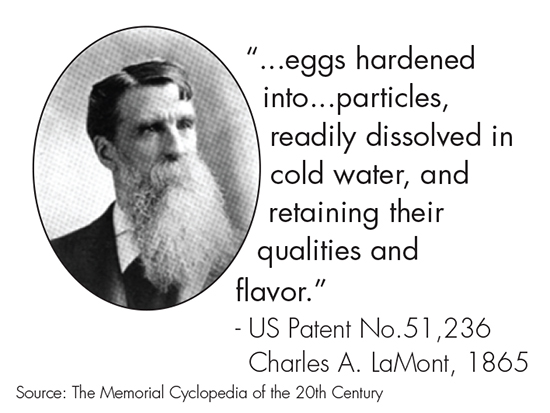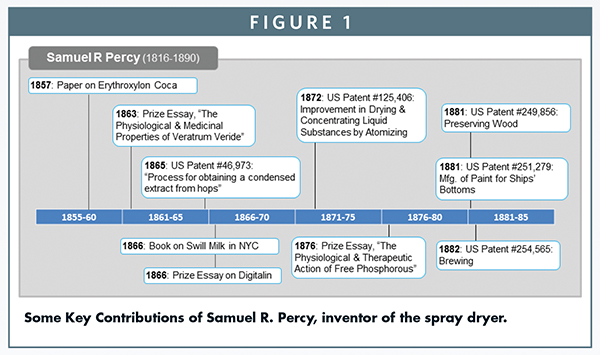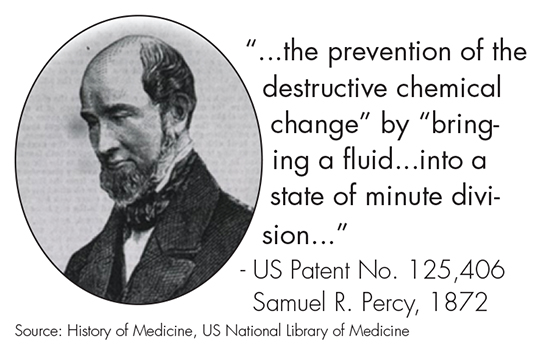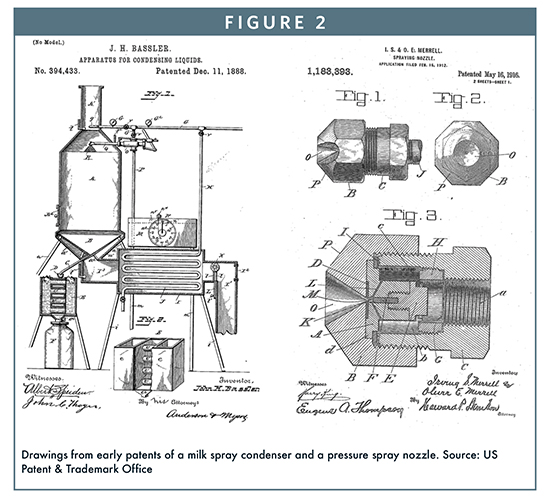Issue:April 2015
THE SECOND QUADRANT - The Birth of Drug Solubilization: 1840 Through 1920
Today’s technologies for dealing with solubilization challenges range from myriad manufacturing and engineering methods, an expanded chemical space, and recently developed in silico formulation techniques. These combine to enable drug candidates to move from concept to clinical trials in a relatively short time. While it may seem as if these technologies have emerged throughout the past 2 decades, their maturation took over a century, and this process itself is an interesting study in innovation diffusion.
The inventions leading to the development of spray drying solid drug dispersions alone is rich and involves a combination of contributions from numerous sectors. In particular, the food and agricultural industries played a pivotal role. In the last half of the 19th century, the US population alone tripled to 76 million. The sheer volume of population, the rural-to-urban migration, and the absence of commercial technology for preservation of perishables resulted in consumption of tainted food and epidemic spread of infectious disease. To help deal with the crisis, in 1848, the US patent office was tasked to carry out chemical analyses of agricultural products. This function was transferred to Abraham Lincoln’s newly formed Department of Agriculture (today the FDA) in 1862.1 During this period, studies of Louis Pasteur and numerous other researchers and scientists also focused on food preservation.
FOOD PRESERVATION: THE BIRTH OF SPRAY DRYING
Desiccation had long been recognized as a viable method for food preservation, and evidence of this technique goes back as far as 14,000 years ago, and it was especially effective when long storage times were desired.2 To the 19th century palate, however, state-of-the-art evaporation techniques severely compromised taste and quality of daily staples such as eggs and milk. To overcome these drawbacks, new techniques and technologies were explored. In 1865, Charles LaMont patented a method for desiccating eggs.3 His invention of forcing “… egg-batter, by means of a powerful blast of air, into a thin spray, which is made to fall through a current of heated air” inherently produced a product with improved appearance. But the key advantages were that the “eggs hardened into …particles, readily dissolved in cold water, and retaining their qualities and flavor.” Quality, performance, and stability – recognized even then as essential for food safety – evolved into critical attributes for pharmaceutical products today.
During that same era, Samuel R. Percy (1816-1890), a chemist and physician, was keenly focused on improving the food supply chain and eradication of food-borne disease. He is recognized as a discoverer of the erythroxylon (cocaine) in 1857, authored prize essays on therapeutic effects of veratrum veride, digitalin and free phosphorous (1863-76), and was awarded numerous patents ranging from preservation of hops and wood, spray drying, processes for brewing, and manufacturing paint (Figure 1).
It was Percy’s invention of spray drying for powderizing milk in 1872, however, that would ultimately advance manufacturing technology for solubilizing drug molecules. His patented process enabled “the prevention of the destructive chemical change” by “bringing a fluid … into a state of minute division” within a chamber of heated air, rendering the product “deprived of moisture”.4 But before this invention could be applied to pharmaceuticals, numerous puzzle pieces had to fall into place.
PUMPS, NOZZLES, POWDER COLLECTORS
At a minimum, the three key components needed for a spray dryer are: 1) a reliable liquid pump; 2) a nozzle to “atomize” the liquid into fine particles; and 3) a method for collecting the dried particles. The industries of food, agriculture, and manufacturing were those in which rapid advances were being made. Pharmaceutical spray drying would be built on these foundations.
The use of pumps goes back 4,000 years, and innovations utilizing air, screw, centrifuge, vacuum, and plunger methods continued through the 1800s. Yet it was the observation that steam engines could act as pumps when run in reverse that launched the next chapter. Henry R. Worthington’s invention of the steam pump in 1840 was the beginning of over a century of progress in this area that continues to this day.5 The first all-metal pump was built in 1849, which served as a key enabler for the liquid pump technique, as patented in 1857.6
The spraying nozzle invention for preserving blood, milk, and other liquids by Robert Stauf in 1901 served as the basis for pressure nozzles used today for atomization.7 Stauf’s nozzle breakthrough was acquired by Merrell-Soule for spray drying of powdered milk, allowing them to extract more than 98% of the moisture of liquid milk. They described their product as, “…ideally preserved milk – soluble, containing the lowest obtainable percentage of moisture, offering no breeding place for bacteria, and free from the strong cooked flavor so noticeable in many other mild powders.”8 Merrill -Soule’s products and patents were skillfully used to dominate the market until the 1920s.
The last piece of the puzzle was an effective method to collect the spray dried product. Powder collection, originally derived from threshers and flour mills, and originated with cheese cloth, bag houses, and then “so-called cyclone”.8 In Merrell-Soule Company’s description of their process, they note that, “Gathering up, after it [the desiccated milk powder] has fallen to a depth of several inches, the milk powder is ready for packing.” In many cases, the process was stopped, and the product was hand-shoveled out of the spray dryer. The first patent for powder collection was granted to Wilhelm F. L. Beth in 1906.9 This completed the list of essential components for the realization of modern spray drying.
INNOVATION: CREATIVE COMBINATIONS OF EXISTING THINGS
While in principle, spray drying is a relatively simple process, throughout the next several decades, components and processes would be invented, improved, and combined to enable pharmaceutical applications. Many hadn’t yet been realized in the time of Percy, and others were emerging for disparate applications in other industries. Even when other equipment, machinery, and manufacturing techniques were being developed, mass production and availability of the building blocks needed to assemble what we use today didn’t yet exist in an applicable format. Patents, publications, and the interactions of inventors formed a virtual hardware store, enabling innovation diffusion across industrial applications.
Developments from the 1920s through the 1960s also had significant impact on the progress of spray drying. The next column in this series will highlight milestones in engineering, the fundamental understanding of the spray drying process, large-scale manufacturing for the war effort, and the ongoing application to a wide range of industries. It was during this period that we observe the birth of physical pharmacy, and the early need to overcome poor solubility in drug products.
REFERENCES
1. www.fda.gov/aboutfda/whatwedo/history/
2. National Center for Home Food Preservation, Brian A. Nummer, Ph.D., “Historical Origins of Food Preservation”
3. US Patent No. 51,263
4. US Patent No. 125,406
5. http://turbolab.tamu.edu/proc/pumpproc/P24/06-tackett.pdf
6. Pumps & Systems, The History of Pumps; USPTO; Agere analysis.
7. US Patent No. 666,711
8. Merrell-Soule Products, Powdered Milk and None Such Mince Meat, published in 1918.
9. US Patent No. 833,117
To view this issue and all back issues online, please visit www.drug-dev.com.

Marshall Crew, PhD, VP, Global PDS Scientific Excellence, Patheon
Total Page Views: 4813













